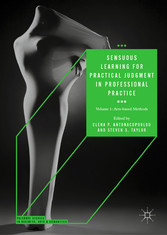Search and Find
Service
More of the content

Sensuous Learning for Practical Judgment in Professional Practice - Volume 1: Arts-based Methods
Contents
7
Notes on Contributors
9
List of Figures
17
List of Tables
19
Sensuous Learning Through Arts-Based Methods: An Introduction
20
References
30
Sensuous Learning: What It Is and Why It Matters in Addressing the Ineptitude in Professional Practice
32
Introduction
32
Ineptitude in Professional Practice: Professionalism Revisited
33
Practising Phronesis: A Critical Mode of Knowing and Sensemaking in Professional Practice
34
Cultivating Character
37
The Voice of Conscience
40
Reflexivity: Reconnecting Ways of Seeing, Being, and Becoming
42
Sensuous Learning: CQ and the GNOSIS 4R Framework
48
Professionals; Are You Realising Y-OUR Impact?
55
References
57
Using Music to Activate and Develop Leader Character
63
Introduction
63
Conceptual Framing
64
Leader Character and Sustained Excellence
64
Music Stimulates
68
Music and Character
72
ABM Through Music
73
Learning Arising from the Use of Music as an ABM
75
Discussion and Conclusions
83
Reflections
84
References
85
Using Choir Conducting to Improve Leadership Practice
88
Conceptual Framing
91
Analogically Mediated Inquiry
93
Embodied Performance
94
Data Collection and a Description of Choir Conducting Workshops
95
Process of Learning
97
Analogically Mediated Inquiry
98
Embodied Performance
103
Evidence of Impacts
106
Lessons Learnt
109
References
110
Using Choral Singing to Improve Employee Well-Being and Social Cohesion in the Norwegian Public Sector
114
Introduction
114
Conceptual Framing: Learning, Emotions and Choral Singing as an Arts-Based Method
116
Context and Content
120
The Process of Learning
122
Impacts
126
Lessons Learned
127
References
129
Using Body Sounds as a Coaching Tool to Promote Individual Growth in Brazil
133
Introduction
133
Arts-Based Methods, Coaching, and Leadership
134
Coaching and Leadership
134
ABM in Context—Body Sound Theory
136
The Case of Andrew—Using Body Sound Theory in Coaching
138
Andrew and the First Meeting
139
The “Contract”—First Meeting
140
Andrew—Second Meeting
141
Andrew—The Third Meeting
143
Andrew—The Fourth Meeting
145
Andrew—The Fifth Meeting
146
ABM Process of Fostering Learning—Using Body Sounds to Elicit Change
147
The Difference This ABM Made—Relationship Building Between Coach/Coachee
149
Reflections—Our Own Learning
150
Conclusion
152
References
152
Using Arts-Based Inquiry as a Way to Communicate Creatively in Uncovering the Future
155
Introduction
155
Conceptual Framing
157
The Power of Symbolising and Play
157
Sensuous Learning, Vulnerability and the Arts
159
Different Approaches to Inquiry
161
Arts-Based Inquiry
162
Content and Context
163
Developing Arts-Based Inquiry
163
The Course Creative Communication
165
The Different Steps in an Arts-Based Inquiry
166
Establishing Working Pairs and Outlining the Theme
166
Choosing a Symbol and Getting Started
167
Embodying and Speaking from the Symbol
167
Sharing and Reflecting on the Process
169
Process of Learning
169
Using Arts-Based Inquiry as an Integral Part of the Teaching
170
Evidence of Impacts
171
Case 1: Discovering Embodied Feelings and Senses
172
Images Providing Learners with New Perspectives
174
Scores After the Course Creative Communication
177
Reflections and Lessons Learned
178
References
180
Using Epic Poems and Creative Drama to Develop Realistic Optimism Among Undergraduate Students in Greece
183
Epic Poems and Creative Drama as Learning Spaces for Developing Realistic Optimism
185
Epic Poetry
186
Time
187
Totality and Multiplicity
188
Creative Drama
189
The Context
190
Designing the Content
191
Objectives
191
Pre-Training Educational Methods
193
Creative Drama Session
194
The Process of Learning
196
Setting the Stage for the Drama to Take Place: Lessons from Odyssey
196
The Play Session
199
Exploring the Play and Linking It to Real Life
201
Some Evidence: The Impact of Odyssey and Creative Drama on Realistic Optimism
202
Lessons Learned
205
References
207
Using “The Staged Cocktail Party” to Improve Leaders’ Social Interaction in the Norwegian Military
210
Introduction
210
Conceptual Framing
212
Theatre
213
Drama
214
Play
214
Playing for Mentalisation
215
Context and Content
216
The Staged Cocktail Party
217
Process of Learning
218
Step 1: Warming Up—Getting the Role
218
Step 2: The Activity—Playing the Role
219
Step 3: Reflection—Stepping Out of the Role
220
The First Level of Reflection
220
The Second Level of Reflection
221
The Third Level of Reflection
222
Impacts
223
Human Interaction
223
Emotional Reactions
224
Leaders’ Mentalisation
226
Lessons Learned
227
Closing Comments
230
References
231
Learning from Arts: Using Abstract Painting to Discover New Understandings and Approaches That Are Relevant for Both Personal Development and Consulting Practice
235
Introduction
235
Learning from Within
236
Initiating and Developing Artistic Inquiry
238
From Visual Journaling to Painting
238
Reimagining Dancer and Shadow
240
Integration of Art and Inquiry
246
Learning Through Art: A Process of Being and Becoming
247
Emergence of a Painter
248
An Arts-Based Approach to Reflexive Learning
249
Artistic Dwelling
250
Growth-in-Connection: Creative Confrontation
252
The Impact of an Arts-Based Inquiry on My Professional Practice
253
Lessons Learned
255
References
257
Using Arts-Based Methods to Explore Learning in an Individual with Systemizing Bias
259
Introduction
259
Discovering a Method for Systemizers
260
The Challenge of First-Person Inquiry
262
The Value of Examining Other People’s Art Work
265
The Challenge of Making Art Myself
268
The Challenge of Using Art with Others
275
Summary and Conclusions
278
References
279
Conclusion—Arts-Based Methods for Sensuous Learning: Questions and Quality
281
Sensuousness as a Choice for Engagement
282
Facilitator Skill
284
Energy
286
Divergence of Outcomes
288
Quality
290
References
292
Index
294
All prices incl. VAT












